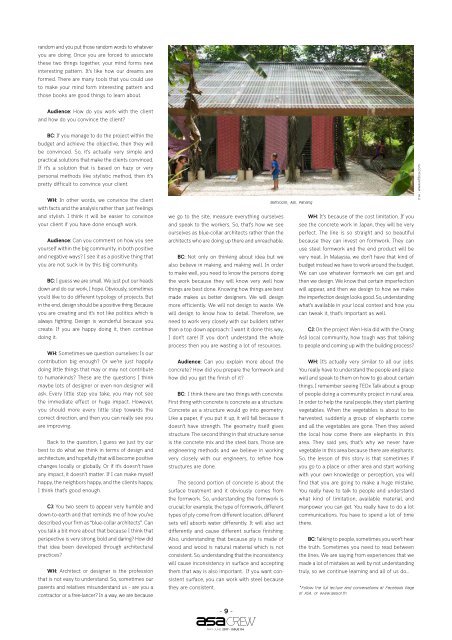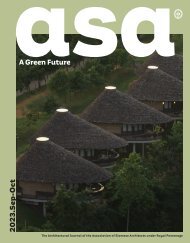ASA CREW VOL.4
You also want an ePaper? Increase the reach of your titles
YUMPU automatically turns print PDFs into web optimized ePapers that Google loves.
andom and you put those random words to whatever<br />
you are doing. Once you are forced to associate<br />
these two things together, your mind forms new<br />
interesting pattern. It’s like how our dreams are<br />
formed. There are many tools that you could use<br />
to make your mind form interesting pattern and<br />
those books are good things to learn about.<br />
Audience: How do you work with the client<br />
and how do you convince the client?<br />
BC: If you manage to do the project within the<br />
budget and achieve the objective, then they will<br />
be convinced. So, it’s actually very simple and<br />
practical solutions that make the clients convinced.<br />
If it’s a solution that is based on hazy or very<br />
personal methods like stylistic method, then it’s<br />
pretty difficult to convince your client.<br />
WH: In other words, we convince the client<br />
with facts and the analysis rather than just feelings<br />
and stylish. I think it will be easier to convince<br />
your client if you have done enough work.<br />
Audience: Can you comment on how you see<br />
yourself within the big community, in both positive<br />
and negative ways? I see it as a positive thing that<br />
you are not suck in by this big community.<br />
BC: I guess we are small. We just put our heads<br />
down and do our work, I hope. Obviously, sometimes<br />
you’d like to do different typology of projects. But<br />
in the end, design should be a positive thing. Because<br />
you are creating and it’s not like politics which is<br />
always fighting. Design is wonderful because you<br />
create. If you are happy doing it, then continue<br />
doing it.<br />
WH: Sometimes we question ourselves: Is our<br />
contribution big enough? Or we’re just happily<br />
doing little things that may or may not contribute<br />
to humankinds? These are the questions I think<br />
maybe lots of designer or even non-designer will<br />
ask. Every little step you take, you may not see<br />
the immediate effect or huge impact. However,<br />
you should more every little step towards the<br />
correct direction, and then you can really see you<br />
are improving.<br />
Back to the question, I guess we just try our<br />
best to do what we think in terms of design and<br />
architecture, and hopefully that will become positive<br />
changes locally or globally. Or if it’s doesn’t have<br />
any impact, it doesn’t matter. If I can make myself<br />
happy, the neighbors happy, and the clients happy,<br />
I think that’s good enough.<br />
CJ: You two seem to appear very humble and<br />
down-to-earth and that reminds me of how you’ve<br />
described your firm as “blue-collar architects”. Can<br />
you talk a bit more about that because I think that<br />
perspective is very strong, bold and daring? How did<br />
that idea been developed through architectural<br />
practices?<br />
WH: Architect or designer is the profession<br />
that is not easy to understand. So, sometimes our<br />
parents and relatives misunderstand us – are you a<br />
contractor or a free-lancer? In a way, we are because<br />
we go to the site, measure everything ourselves<br />
and speak to the workers. So, that’s how we see<br />
ourselves as blue-collar architects rather than the<br />
architects who are doing up there and unreachable.<br />
BC: Not only on thinking about idea but we<br />
also believe in making, and making well. In order<br />
to make well, you need to know the persons doing<br />
the work because they will know very well how<br />
things are best done. Knowing how things are best<br />
made makes us better designers. We will design<br />
more efficiently. We will not design to waste. We<br />
will design to know how to detail. Therefore, we<br />
need to work very closely with our builders rather<br />
than a top down approach: I want it done this way,<br />
I don’t care! If you don’t understand the whole<br />
process then you are wasting a lot of resources.<br />
Audience: Can you explain more about the<br />
concrete? How did you prepare the formwork and<br />
how did you get the finish of it?<br />
BC: I think there are two things with concrete.<br />
First thing with concrete is concrete as a structure.<br />
Concrete as a structure would go into geometry.<br />
Like a paper, if you put it up, it will fall because it<br />
doesn’t have strength. The geometry itself gives<br />
structure. The second thing in that structure sense<br />
is the concrete mix and the steel bars. Those are<br />
engineering methods and we believe in working<br />
very closely with our engineers, to refine how<br />
structures are done.<br />
The second portion of concrete is about the<br />
surface treatment and it obviously comes from<br />
the formwork. So, understanding the formwork is<br />
crucial; for example, the type of formwork, different<br />
types of ply come from different location, different<br />
sets will absorb water differently. It will also act<br />
differently and cause different surface finishing.<br />
Also, understanding that because ply is made of<br />
wood and wood is natural material which is not<br />
consistent. So, understanding that the inconsistency<br />
will cause inconsistency in surface and accepting<br />
them that way is also important. If you want consistent<br />
surface, you can work with steel because<br />
they are consistent.<br />
Bathroom, Asli, Pahang<br />
WH: It’s because of the cost limitation. If you<br />
see the concrete work in Japan, they will be very<br />
perfect. The line is so straight and so beautiful<br />
because they can invest on formwork. They can<br />
use steel formwork and the end product will be<br />
very neat. In Malaysia, we don’t have that kind of<br />
budget instead we have to work around the budget.<br />
We can use whatever formwork we can get and<br />
then we design. We know that certain imperfection<br />
will appear, and then we design to how we make<br />
the imperfection design looks good. So, understanding<br />
what’s available in your local context and how you<br />
can tweak it, that’s important as well.<br />
CJ: On the project Wen Hsia did with the Orang<br />
Asli local community, how tough was that talking<br />
to people and coming up with the building process?<br />
WH: It’s actually very similar to all our jobs.<br />
You really have to understand the people and place<br />
well and speak to them on how to go about certain<br />
things. I remember seeing TEDx Talk about a group<br />
of people doing a community project in rural area.<br />
In order to help the rural people, they start planting<br />
vegetables. When the vegetables is about to be<br />
harvested, suddenly a group of elephants come<br />
and all the vegetables are gone. Then they asked<br />
the local how come there are elephants in this<br />
area. They said yes, that’s why we never have<br />
vegetable in this area because there are elephants.<br />
So, the lesson of this story is that sometimes if<br />
you go to a place or other area and start working<br />
with your own knowledge or perception, you will<br />
find that you are going to make a huge mistake.<br />
You really have to talk to people and understand<br />
what kind of limitation, available material, and<br />
manpower you can get. You really have to do a lot<br />
communications. You have to spend a lot of time<br />
there.<br />
BC: Talking to people, sometimes you won’t hear<br />
the truth. Sometimes you need to read between<br />
the lines. We are saying from experiences that we<br />
made a lot of mistakes as well by not understanding<br />
truly, so we continue learning and all of us do...<br />
*Follow the full lecture and conversations at Facebook Page<br />
of <strong>ASA</strong>. or www.asa.or.th<br />
ภาพ : www.whbca.com<br />
- 9 -<br />
MAY-JUNE 2017 - ISSUE 04


















